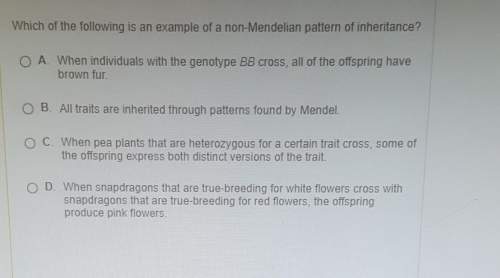
Biology, 24.11.2019 06:31 queenkimm26
Ayeast cell is transported from an environment with oxygen to a completely oxygen-free environment. which of the following answer choices best describes the metabolic changes that will occur in the yeast cell? choose 1 choose 1 (choice a) a glycolysis will still occur and pyruvate will undergo alcohol fermentation, but the krebs cycle and oxidative phosphorylation will not occur. (choice b) b glycolysis will still occur, but pyruvate will not form, causing the yeast cell to undergo alcohol fermentation. (choice c) c glycolysis will still occur, pyruvate will still form, causing the yeast cell to undergo lactic acid fermentation. (choice d) d glycolysis will not occur and pyruvate will not form, causing the yeast cell to undergo alcohol fermentation.

Answers: 2


Another question on Biology

Biology, 22.06.2019 03:00
The unique structure of the neuron is dedicated to the efficient and rapid transmission of neural signals. the relationship between neurons, the spinal cord, and the brain constitutes an elaborate communication system throughout the human body. all but one of the functions listed below are a result of this interaction.
Answers: 1

Biology, 22.06.2019 15:00
How do temperature and salinity affect deepwater currents? question 15 options: as temperatures and salinity levels of water increase, the water rises to the surface where it creates currents as it moves to colder regions. they create changes in wind direction, moving denser water in the same direction as the wind and causing the deepwater circulation patterns found in the ocean. they equalize the forces on undersea currents caused by the coriolis effect as they replace more dense water with less dense water. they create density differences that cause dense deepwater currents to flow toward the equator where they displace less dense, warmer water above them.
Answers: 2

Biology, 22.06.2019 17:30
Sally, age 3 months, has a moist, red, vesicular rash on her cheeks, the backs of her hands, and her arms. her mother said sally was constantly trying to scratch the rash and often has difficulty sleeping. her father has a family history of allergic rhinitis and asthma. discussion questions. 1. review atrophic dermatitis from chapter 3 and discuss the pathophysiology of sally’s symptoms. 2. why is the father’s medical history significant, and what can sally expect as she grows up? 3. discuss the need to limit scratching, and describe practical methods to achieve this.
Answers: 3

Biology, 22.06.2019 19:00
The assembly called for a "bill of rights" that would list u.s. citizens'
Answers: 2
You know the right answer?
Ayeast cell is transported from an environment with oxygen to a completely oxygen-free environment....
Questions

Social Studies, 26.12.2019 05:31


Social Studies, 26.12.2019 05:31



Social Studies, 26.12.2019 05:31



Advanced Placement (AP), 26.12.2019 05:31

Spanish, 26.12.2019 05:31

Chemistry, 26.12.2019 05:31




History, 26.12.2019 05:31




Business, 26.12.2019 05:31




